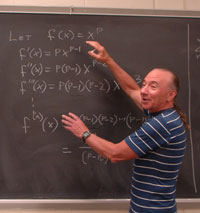It All Adds Up: Running, teaching and math.
It All Adds Up: Running, teaching and math.

The year: 1961. President John F. Kennedy is sworn into office. Yankee Roger Maris bests Babe Ruth for single-season homers (61 in 61!) And Rowan math Professor Tom Osler teaches his first class.
Dr. Osler, a soft-spoken, good-natured instructor approaching his 50th year in the classroom, started teaching just as the Cold War was heating up. One might say his career was propelled by it.
“The Russians had sent Sputnik into space in 1957 and the U.S. was pouring money into technology to catch up with them,” recalled Dr. Osler, then a physics major at Drexel University in Philadelphia. “That created a vacuum in teaching.”
A Camden native who’d been considering a career in engineering, Dr. Osler suddenly had an opportunity, while still an undergraduate himself, to teach his first calculus course.
“After my first week of teaching I knew I was not going to be an engineer,” he said.
Five decades in, still running strong
A 1957 graduate of Camden High School, Dr. Osler earned his bachelors degree in physics in 1962, his MS in mathematics at New York University in 1969 and his Ph. D. in mathematics at NYU in 1970.
Fit and seemingly younger than his 69 years, he’s been an avid runner since high school and won his first national championship, a 25k race, in 1965. A second national title, for a 30K race, came two years later. In 1967 he finished 19th in the Boston Marathon and, later that year, self-published a highly regarded manifesto, The Conditioning of Distance Runners.
“It’s probably the best thing I ever wrote on running,” Dr. Osler noted on his personal web site. “Only 32 pages and still circulating underground.”
Like most things, running was different then, he said. Exercise, especially serious, competitive exercise, was somewhat of a fringe activity and high-tech clothing and footwear was unheard of.
“I won my national championships in street shoes,” he said.
Born to Run (and teach)
Dr. Osler, who continues to run about 50 miles a week, is humble about his accomplishments both as a runner and a mathematician. (He’s competed in more than 2,100 races and was honored last spring with a prestigious teaching award, the MAA New Jersey Section Award for Distinguished College or University Teaching of Mathematics. In an interview he mentioned neither.)
He’s popular with students in part for his humility and demeanor but possibly more accomplished for his work in the classroom than on the track.
Now in his 49th year as a mathematics professor, he’s published more than 120 mathematical papers and helped more than 40 undergraduate students get published too.
“I may not be the world’s greatest mathematician but I really love mathematics,” he said. “I’m not the world’s greatest runner either but I was born to do both.”
Married for 41 years, he has two sons, one of whom is a carpenter, the other a math professor at Atlantic Cape Community College in Mays Landing.
Dr. Osler fully recovered from a stroke at 63 and now, approaching 70, sees no reason to retire.
“I like being on stage, standing in front of a class,” he said. “And I like being around young people. I could spend my time around older people, but I like being around young people.”
Dr. Osler said the Rowan math program is a popular one with about 20 full-time faculty members and some 350 declared majors. As for career paths that start with a math degree, it’s a very big field.
“The greatest percentage probably become teachers,” he said. “But engineering is popular, as are other areas of science, and some become actuaries. A bachelor’s degree in mathematics is highly regarded even in fields like law. Law schools like math majors because they think very precisely.”
Matthew Oster, a 2007 Rowan graduate who studied with Dr. Osler, is working on a Ph. D. in Operations Research at Rutgers University in New Brunswick.
While at Rowan Oster published two mathematical papers in academic journals under Dr. Osler’s tutelage.
“He has a great interest in the material he presents,” Oster said. “He’s animated about the material and that gets the students excited as well.”